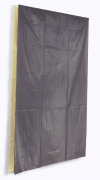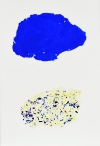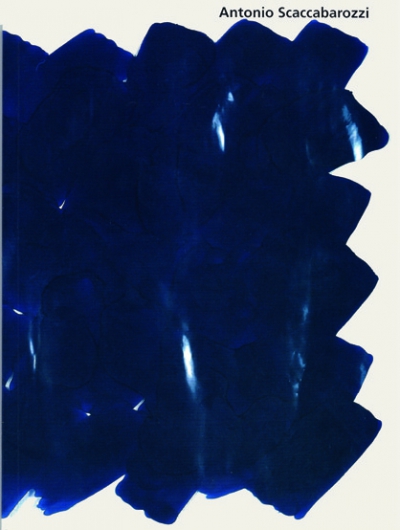Antonio Scaccabarozzi - His Work
Antonio Scaccabarozzi was born in the town of Merate, northeast of Milan, in 1936. He attended the Castello Sforzesco College of Applied Arts in Milan from 1954-1959. His training took place at a time when informal and Iyrical abstract art still dominated in Western Europe, though other tendencies of informal art, which also proved to be the direction of the future, were evolving in many areas.
The informal movement, in itself not one single style, was, of course, never free of the vehement contradictions expressed by, for example, the abstract/concrete and various figurative schools. In 1960, however, the first successful movement of young artists formed in opposition to the spontaneous gestures, subjective imagination and the random structural form of the informal school. An unusually large number of artist groups came into being during this period. They were not only an expression of the new, democratic-pluralistically based awareness, but also an indication of the growing need to move on from doctrinaire, old-fashioned positions via new artistic concepts. A dozen new artists' groups, formed between 1959 and 1965, are in themselves evidence of the atmosphere of opening doors, moving in new directions and of the productive and creative activity in Italy at that time. The Milan Group T with Gianni Colombo was established in 1959 and 2 years later the Continuità Group with Argan, Dorazio, Fontana and the two Pomodoros.
The formation of new, active cells was not an isolated phenomenon, but took place Europe-wide, if not internationally: While Pierre Restany was propagating Nouveau Réalisme in Paris in 1959, the protagonists of the Zero Group in Dusseldorf were formulating their basic aims. Comparable groups developed in Saarbrucken, the Neue Grouppe Sarr, and in the Netherlands, the Group Nul. The groups mentioned decided to dub the artistic movement which was breaking with the informal Nouvelles Tendances. Such catch phrases are useful as agreed-upon collective labels but have the disadvantage of being unspecific generalizations. What is important; here is that Nouvelles Tendances had different starting points which were reflected in their different visual results. Their common base was the importance placed on attitude, starting with innovative impact with its conscious intent of shoring up the burden of tradition in order to determine the basic conditions of art and visual perception. They wanted to start over, to explore the fundamentals. Just as the subconscious and the psychological state as the mysterious source of creative inspiration had previously been the focus of artistic interest, the vehicle itself became the subject of extensive investigation. Logic and systems, transparency and measurability became the defining factors in creative expression, whose analytical approach is hard to imagine without knowledge of the methods used in natural science.
At that time, in 1960, the 24-year-old Scaccabarozzi left Milan, then a center of the Italian avant-garde, to live in Paris for 5 years. He made several trips during those years, including to the Netherlands and England. At the beginning of the 60s, Paris was still the cosmopolitan center of the increasingly international art world, a repository of the new and avant-garde. The young Scaccabarazzi first developed a non-figurative style, whose gesticulative elements suggest an orientation to the traditions of Iyrical abstraction (Mondossico No. Il, 1962). This style of emotional painting was - as far as can be ascertained from the few photographs of his works from the time in Paris - only a transitory phase on the way to other contrary goals. In Milan, where Scaccabarozzi returned in 1965, he developed a style of painting in which the individual element as an expression of subjectivity was abandoned in favor of a rationally founded one with an objective working concept. Although conventional paintings in the technical sense, the pictures starting in 1966 have no sign of a personal touch. Each is a sort of neutralized instance within a series of step-by-step studies in which the basic conditions of painting are questioned. This experimental approach and the direct handling of painting materials links Scaccabarozzi to other italian artists such as Fontana, Manzoni, Castellani and Colombo.
Starting in 1966, he paints in series of various thematic focuses. Their sequence demonstrates both the logical construction and the universality of the conceptual design, Scaccabarozzi explored fundamental aesthetic questions which were recurring topics in the Milan MAC (Movimento per l'Arte concreta) as early as 1948.
Equilibrio Statico Dynamico
The first series of works explores the balance between static and dynamic picture elements. Equilibrio Statico Dynamico from 1966 is still based on traditional painting. Diagonale, from the same year, is also still a traditional canvas painting (Fig. 13). The standing triangle is divided into two congruent triangles by a line which runs from the upper left to the lower right. The right half is a monochromatic gray while the left is an irregular white. A very simple structure is used for the purpose of demonstrating questions of basic aesthetic significance: the identity of form and conditions of its relativity. Admittedly, the triangle divided by a diagonal line contains two identical triangles, equal in shape, area and with equal angles. What distinguishes them, however, is their position within the larger triangle. The white triangle on the left stands on its base, which acts as a foundation. It appears settled and its dynamic qualities unfold upward. The gray triangle, swaying on a point, gives the opposite feeling of movement and instability. Its energy flows downward. This is also because gray evokes more a feeling of weight and calm whereas immaterial white conveys a feeling of weightlessness and bodilessness. Another phenomena deserves attention: What is the relation of the two triangles to each other? Are they equal entities juxtaposed or does the gray one stand out against a white background, vaguely reminiscent of a triangle? Consequently, Scaccabarozzi is dealing here with the themes of visualization of the relationships of parts to each other and to the whole, the weight of colors dependent on the areas to which they are assigned, and questions of form which he repeatedly explores in other series of works. In two monochrome pieces, Diagonale and Profilo, painted a year later, Scaccabarozzi goes a step further. The small-scale, blue standing triangle, Diagonale (Fig.12), is once again divided diagonally, this time in the direction we write, so to speak, from bottom left to top right, creating a feeling of ascending, a feeling of linear dynamics. Whereas the left half of the painting, with its smooth, monochrome surface, seems to float inactively, the right half attains an even rhythm through the vertical ridges created by the corrugated cardboard of its surface. Both halves of the painting have similarities with the 1966 Diagonale mentioned above. The materials, form and surface area are identical. The difference is that in this case even the color treatment has become uniform. The differentiation of the two halves into a vague and more static one and a lively, colorful one is created solely by a change in surface structure, using either side of the same material. The uneven ribbed surface activates the light. Light gathers on the ridges, shadows in the valleys, so that the monochrome blue is broken up into a broad spectrum of different tones. The playful use of the reverse sides or the exploration of the relation of effects of their interactive influence appears here for the first time and reappears in later works. Profilo (Fig. 11), mentioned above, juxtaposes two vertical red fields of almost the same size. This sensitive work also deals with the complicated balance between static and dynamic elements. When the viewer tries to pull together the two picture halves which appear to be separated by a vertical disruption into a unified whole, he is confronted by characteristics which reveal not only the differences but also the independence of the two parts. The red tones of the two sides are so dose that they can be said to have a relationship, but are so different that they cannot be put together into a homogeneous whole. Both sides have a distinctive structure. The left side, with its straight and precise borders, appears tight and hermetically sealed. The other side, with its uneven borders, seems more open and variable. Thus two contradictory characters of form are placed side by side. An interaction develops between them like the tension between the poles of attraction and repulsion.
Strutturali
The paintings mentioned above deal with the relationship of monochromatic areas to one another. In 1969 Scaccabarozzi started working with wall objects in relief in which the dot as the constituent structural element is the focus of study. The monochromatic and polychromatic wood reliefs incorporating light modulation were soon followed by ones on which small round pieces of canvas are punched and folded out from the surface. An example is Sovrapposizione e Rotazione Sulla Orizzontale (1973) measuring 36 x 36 cm (Fig.14). Here, a square grid has been used as the basic system of organization far circles which have been cut and folded out of the picture's surface at random angles, projecting varying ovail shadows. Only when the viewer has observed the piece from different angles and, if possible, at different times of day, does the endless variety of possible appearances become apparent. The more a piece incorporates design elements which give it a dynamic structure, the more dependent it is on their being activated through reception. The collection of works entitled Strutturali concludes with structures made of painted, colored dots, so-called Prevalenze (Fig.15). A 1976 brochure from the Lydia Megert Gallery in Bern aptly wrote: "What is actual/y dominant in these pictures? The basic structure which is always the same, or the ever-changing perceptual effect created by the modification of the various tones and the size of the dots? The exchange between positive and negative or the steadfastness of the construction itself? And in what appears as a series of layers ... does the background or the foreground dominate, or is it the layers between? The questions are endless. They result in situations of stimulating double meaning created through minimal variations which move through the whole. This makes deciphering the picture and its many meanings anything but easy ... "
Misurazioni
In 1979 the basic problems of relativity and multiple meaning in rationally ordered systems explored in Strutturali were followed, one could say logically, by explorations of measure, scale and measurability in Misurazioni. The work Misura Reale-Misura Rappresentata from 1979 (Fig.16) exemplifies the starting point of this group of works. A slice of nature the dimensions of which are visibly defined by means of a scale, is transposed into the unreal scale of photography and then presented in correlation with its real physical scale.
The discrepancy between the actual scale, the representational scale and reality of real space becomes evident. Knowledge and sensual perception diverge. The viewer is compelled not to use reason and rationality as the measure of all things. Scaccacarozzi takes a critical look at scale in different ways. A formless and qualityless sel-evident truth is first raised to aesthetic nobility through experience and poetic distance. The parameters of measure are unimportant. While dimensions, as neutral units, can determine the characteristics of a work of art. the poetry of distance means a particular approach with which the contradictions can be exposed. In 1980, Scaccabarozzi wrote on this subject: The most recent ... experiments, entitled Canvas Injections, paradoxical/y view scale as volume in space, in which a specific amount (cubic mil/imeters or cubic centimeters) of diluted paint is injected into the canvas, absorbed and then spreads to create two-dimensional areas. Another paradox is created when the spatial measure is called into question by visual perception. When, for example, I inject 25 cm3 of paint at one time, I get a surface area of x cm2. But when I inject only 7 cm3 25 times, I have used the same volume of paint, but the visual effect contradicts this fact. " Even though these works are impregnated with deep philosophical seriousness, they radiate a sensuality reminiscent of the sinister practices of alchemy. The painterly results obscure the conceptual starting point (fig.18,19). The wealth of variation in the blue which flows over the canvas spreading into fields with delicate edges or drawing together into a lush pool of pigment, is fascinating. The spreading of the color seems to be a dynamic process which has only been halted temporarily. Scaccabarozzi dearly shows through different experiments that conventional measurements change when confronted with poetic experience. He draws straight, parallel line freehand. Their straightness and weight depend on individual conditions of their creation. In other works he attempts to quantify time as a surface. It is represented as a series overlapping layers of drawings where past and present emerge through as a sort of space in time. The increasing density of the drawings stands for a deeper gradation in time-space. Moreover, Scaccabarozzi explores the relation between the weight of paint and its optical weightiness. Dried paint splotches of equal weight are stuck on the canvas in a row, revealing their different expansion, density, brightness and form (Fig.17)
Quantità
This simple title refers to a series of works that was started in 1983 and deals with the reciprocal relationship between amount of paint and area of paint, where quantity of paint and its spread is made dependent on the motor-gestual painting processo In these predominantly monochrome paintings, the density or transparency of the color shape is also an expression of the energetic potential of spontaneous painting movements which contribute to defining the structure. At the point where the paint brush paused at the start, the pigment has collects, deepening, for example, from blue to black. At the place where it lightly brushes the surface, the color intensity lessens and fades to a pale trace. This is particularly apparent at the edges of the color areas where the generally slightly diagonal movement of the brush strokes is visible. Here the differentiations in color density are particularly rich, and quantity affects the painting as potential, as energy, as quality itself.
The first Quantities(Fig. 21-23, 27) are painted on sheets of transparent polyethylene, a lightweight, pliable, paper-thin and thus fragile plastic, elevated to artistic height for the first time since its sporadic use in Pop Art. It is a particularly poor, short -lived wearing material. Its restricted unpretentious qualities reflect the material- asthectic concepts of Arte Povera. The plastic sheet binds a specific amount of paint on its surface with the first brush stroke, similar to water color painting. It then becomes saturated and changes cannot be made. The painted surface thus defines the amount of paint. It has to be applied quickly and with large movements. The formless paint is drawn to the plastic and fuses together with it to form a single unit. The plastic sheet, lacking compact volume, at first adheres to the wall due to static electricity until with time ... , in reaction to temperature, it moves away from the wall ... and develops its own body, casting folds and waves which become colorless light reflections or color reflexes (Christine Brunner, 1986). At the same time as Scaccabarozzi was working with plastic, he also painted large-scale, water color drawings , acrylic paintings on canvas as well as works on paper, in which a second color is spread over a contrasting base color. The process of movement in the paint application remains visible and constitutes the surface structure in which tension is created between upper and lower, between the denser middle and open edges. The first painted newspapers appeared in 1987. Transparent colored car paint becomes a surface quantity through which the predetermined surface of graphic print comes through. It develops its own range of color through the interaction of the gray tones with the varnish. The static framework of the page's clean-edged format, the type area, the parallel lines, the columns, the typographical hierarchy, etc. obtain a new meaning by being absorbed, so to speak, in a higher color system and at the same time obtain a new relevance, free from the banal burden of short-lived everyday events. As with the painted newspapers starting in 1989, the theme is the homogenization of the total appearance, the poetic-painterly balance between two competing systems.
Essenziali
Since 1990 Scaccabarozzi has been working on Paint Pieces (Fig. 26, 28, 30, 34). These are unstable, limp, leathery works reminiscent of animal skins. Their uniqueness makes it impossible to classify them according to traditional categories of painting or relief. In Essenziali the paint has detached itself from the physical ground of the painting and become independent. It has an autonomous existence. What we see is the pure paint material, only the paint as the essence of painting. The paint is applied thickly with a palate knife in broad stokes, organized in diagonal rows to form a rectangular, usually monochromatic color surface characterized by pronounced relief. Each palate knife stroke absorbs and conserves the motion to which it owes its existence as creative energy.
The discovery of the plastic energy potential of paint is nothing new, but neither in the Ecole de Paris norwith representatives of the Cobra Group does it move beyond the role assigned to it in a specific function in the painting. It is not a theme in itself, the centrai object of the painting. It would be tempting to describe Sccacabarozzi's Essenziali as absolute painting if the term had not already been used. It leads back along a long path of self-reflection to the starting point where the foundations of elementary asthetics are revealed.
Wolfgang Vomm
[Catalogue made by Gallerie Hoffmann, Friedberg, D. e Katrin Rabus, Bremen, D.]







